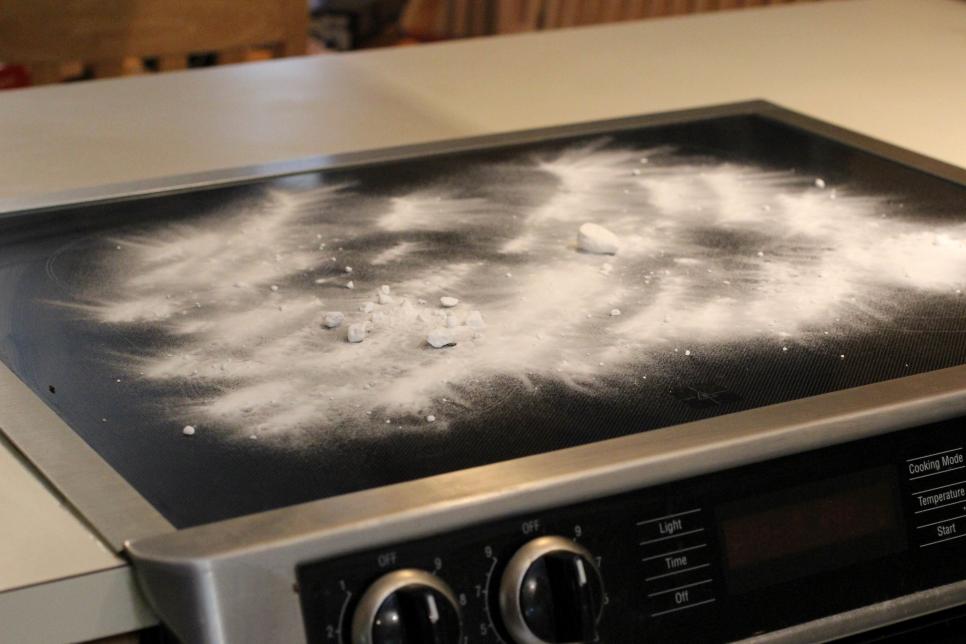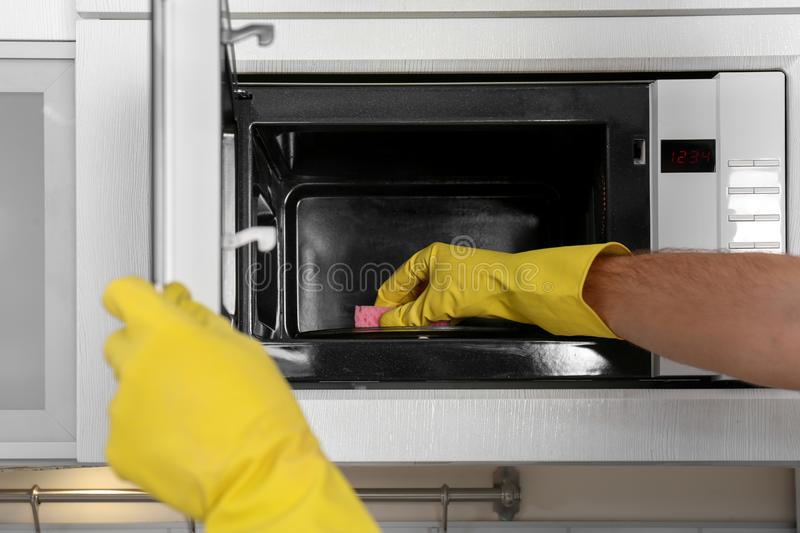If you’re looking for the best way to clean your electric stove, try using a baking soda paste made with three parts baking soda and one part warm water. This simple household ingredient can help remove grease, stains, and charred remains from your stovetop, leaving it looking like new.
If you’re unfamiliar with the most effective cleaning strategies, you may find it challenging to clean your electric stove. Many electric stoves have coil burners, and an increasing number are made with glass stove tops, which require extra care during the cleaning process to avoid scratching.
Contrary to what you may think, cleaning your electric stove is much simpler than you think, and similar steps can be adopted when cleaning your microwave. Using household ingredients and following simple steps, you can make your stove shine again in just a few minutes.
- To get rid of grease, stains, and charred remains on your electric stove, follow these steps:
- You will need the following supplies:
- Below is a step-by-step guide on the most effective way to clean an electric stove top
- How do you get burn marks off an electric stove?
- How do I keep my electric stove clean?
- How do you degrease an electric stove?
- How do you clean an electric stove top with vinegar?
- What is the best cleaner for glass top stoves?
- How to Clean Electric Stove Drip Pans?
- Can electric stove tops be cleaned the same way as gas stoves?
To get rid of grease, stains, and charred remains on your electric stove, follow these steps:
- Start by removing the burner grates and drip pans from your electric stove. Use baking soda and water to create a paste and apply it to the stovetop.
- Allow the baking soda paste to sit briefly to break down tough stains.
- Use a sponge or scrub brush to scrub the stovetop and remove grime or food particles.
- Wipe the stove top with a towel to remove any excess cleaning solution.
- Finally, clean the outside of the stove using glass cleaner or a mixture of soap and water.
This article will provide a step-by-step guide on how to clean an electric stove top, including the supplies you will need and the best cleaning methods to use.
You will need the following supplies:
- A soft cloth or sponge
- Warm water
- Mild dish soap
- Baking soda
- A toothbrush or scrub brush
- Vinegar
Below is a step-by-step guide on the most effective way to clean an electric stove top
1. Start by removing the burner grates and drip pans from your electric stove if your stove has them

Before cleaning your electric glass stove top, remove any removable parts, such as the burner grates and drip pans. This will make it easier to access the stovetop and clean it thoroughly. To remove the burner grates, lift them and set them aside. To remove the drip pans, lift them out of their slots and set them aside.
2. Use baking soda and water to create a paste and apply it to the stovetop.

Baking soda is a natural cleaning agent that can break down tough stains and grime on your electric glass stove top. To make a baking soda paste, mix three baking soda and one water in a small bowl. The consistency of the paste should be thick enough to spread onto the stove top without running off.
3. Allow the baking soda paste to sit for a few minutes to break down tough stains.
If you have a lot of crud on your stove, it’s best to let it sit for a few minutes before scrubbing. The baking soda will bubble and foam up as it cleans the surface, so we suggest waiting five or ten minutes before wiping off any leftover residue.
If you still have trouble getting the grime off, use an old toothbrush or spray cleaner on the affected areas. You may need to scrub at some spots if they are particularly stubborn.
4. Use a sponge or scrub brush to scrub the stovetop and remove grime or food particles.
Use a sponge or cloth to spread it evenly over the surface of the glass stove top. Be sure to cover all areas, including the edges and corners, where grime and food particles tend to accumulate.
When scrubbing, pay attention to all the corners and crevices of the stovetop, as these areas can easily accumulate grime and food particles. Use circular or back-and-forth motions to loosen and lift the dirt and grime from the stove’s surface.
5. Wipe the stove top with a towel to remove any excess cleaning solution.

Wipe the area with a towel. Use a clean towel that has not been used to clean anything else in your home. If you don’t have any clean towels, use paper towels instead—but make sure they’re dry!
6. Finally
Clean the outside of the stove using glass cleaner or a mixture of soap and water. This will help keep your electric stove looking new.
Use a clean cloth to wipe down the outside of the stove. You can also use glass cleaner or soap and water if you have it handy, but I prefer paper towels for this step because they’re less messy than sponges and have a better non-scratch surface than glass does.
If there are any stubborn food stains on your stovetop, use vinegar instead of water (or even better yet—vinegar alone).
How do you get burn marks off an electric stove?
If you have burn marks on your stove, use a damp cloth to wipe them away. If the marks are stubborn and won’t come off easily, try using lemon juice or vinegar to remove them.
How do I keep my electric stove clean?
- Use a damp cloth to clean the stovetop. This is the most essential thing you can do to keep your electric stove clean. Just wipe it down with a wet cloth and then dry it with another.
- Use a damp cloth to clean the drip pans and other parts of your electric stove that collect food residue, such as inside ovens or on grates. These are also easy-to-clean places—rub them down with soap and water when needed!
How do you degrease an electric stove?
- Heat the stove for around a minute.
- Pour water onto the stove.
- Sprinkle baking soda on the stove.
- Allow the baking soda to sit for a few seconds.
- Wipe the baking soda around with a washcloth.
- Squirt some dish soap onto a scrubby sponge and gently scrub the affected area.
- Wipe away the residue with a towel.
Rinse off an electric stove with water after cleaning. This will remove any remaining degreaser and prevent it from building up on your appliance. You can use a sponge or paper towel to wipe down the stove, but make sure you do not apply too much pressure, as this could cause damage to the surface of your stove. Leave some time for the degreaser to sit on your stove before wiping it off with another paper towel or clean cloth (or scrubbing brush).
Repeat this process until no more dirt or grime comes off easily when rubbing against a paper towel or cloth/scrubber.
Here’s a video to show you how to clean a glass stovetop.
How do you clean an electric stove top with vinegar?
Vinegar is a great cleaner for glass stove tops. It’s an inexpensive, natural disinfectant that cuts grease and grime, making it an ideal choice for cleaning your electric stove top. The acidity of vinegar helps break down grease on the cooking surface, so you don’t have to use harsh chemicals or abrasives to get rid of it.
Vinegar also kills mold and mildew, which can build up if you don’t clean your electric stove often enough.
What is the best cleaner for glass top stoves?
The best cleaner for a glass-top stove will depend on the type of stains or dirt you are trying to remove. However, there are a few general guidelines to follow when choosing a cleaner for a glass-top stove:
- Use a cleaner specifically designed for glass top stoves: These cleaners are formulated to be gentle on the delicate surface of a glass top stove and are typically more effective at removing tough stains and grime.
- Avoid using abrasive or corrosive cleaners: Glass top stoves are sensitive to scratches and damage, so it is important to avoid using cleaners that contain abrasive particles or chemicals that may damage the surface.
- Test a small, inconspicuous area before cleaning the entire stove top: This will help you determine if the cleaner is safe to use on your specific stove and ensure that it does not cause any damage.
- Follow the manufacturer’s recommendations: It is always a good idea to follow the manufacturer’s recommendations for cleaning your specific stove model. They will have specific guidelines for the best cleaners on your stovetop.
Some popular cleaners for glass top stoves include Weiman Cooktop Cleaner and Polish, Cerama Bryte Cooktop Cleaner, and Bar Keepers Friend Cooktop Cleaner. These cleaners are designed to be gentle on glass top stoves and effectively remove stains and dirt.
How to Clean Electric Stove Drip Pans?
Cleaning the drip pans is important to keeping your electric stove clean and free of any unwanted buildup.
- Use a non-abrasive cleaner. Your drip pans are typically made of Stainless steel, so avoid using abrasive cleaners like steel wool or scouring pads on them as they can scratch the surface.
- Use soft cloths to wipe off the drips from the drip pans after cleaning them with a non-abrasive cleaner. This will help prevent scratches on their surfaces, which are difficult to repair once scratched up already!
- Use sponges when cleaning large areas (such as all six burners) at once; this way, you won’t have to worry about getting too much liquid onto your hands while doing this step!
Can electric stove tops be cleaned the same way as gas stoves?
Electric stoves are easy to clean. There are different types of electric stoves, but the most common ones are glass-top electric ranges with an easy-to-clean surface on top of a base unit that heats food. These can be cleaned in the same way as gas stoves: using water and soap or vinegar to remove grease buildup from around their heating element or heating plates or using baking soda to scrub away baked-on food debris from their surfaces.
Summary:
The best way to clean an electric stove is to use the same method as a gas stove. If there is any grease or gunk left on your stove, it will be difficult to remove once the oven has been turned off. Using vinegar or baking soda paste will help remove this residue from your electric stove and make it look new!
You may also like:

John Brown
John Brown brings a wealth of experience and passion for DIY, Home and Garden, and Woodworking. With a dedication to empowering enthusiasts, he shares insights, tips, and comprehensive guides to help you transform spaces and master woodworking skills.

